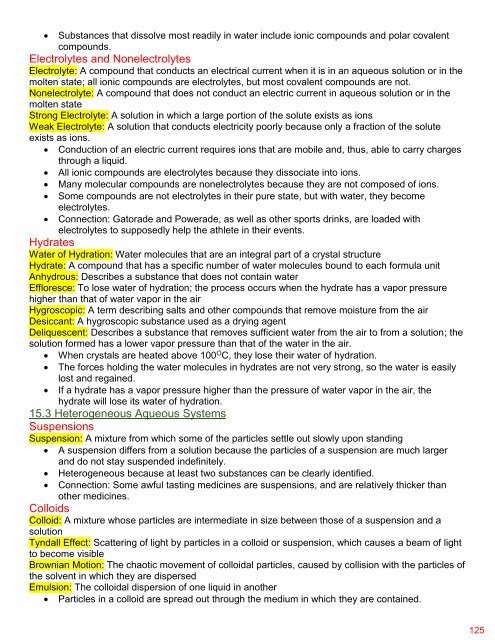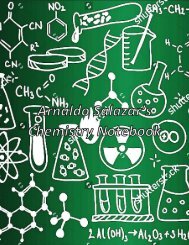You also want an ePaper? Increase the reach of your titles
YUMPU automatically turns print PDFs into web optimized ePapers that Google loves.
Substances that dissolve most readily in water include ionic compounds and polar covalent<br />
compounds.<br />
Electrolytes and Nonelectrolytes<br />
Electrolyte: A compound that conducts an electrical current when it is in an aqueous solution or in the<br />
molten state; all ionic compounds are electrolytes, but most covalent compounds are not.<br />
Nonelectrolyte: A compound that does not conduct an electric current in aqueous solution or in the<br />
molten state<br />
Strong Electrolyte: A solution in which a large portion of the solute exists as ions<br />
Weak Electrolyte: A solution that conducts electricity poorly because only a fraction of the solute<br />
exists as ions.<br />
Conduction of an electric current requires ions that are mobile and, thus, able to carry charges<br />
through a liquid.<br />
All ionic compounds are electrolytes because they dissociate into ions.<br />
Many molecular compounds are nonelectrolytes because they are not composed of ions.<br />
Some compounds are not electrolytes in their pure state, but with water, they become<br />
electrolytes.<br />
Connection: Gatorade and Powerade, as well as other sports drinks, are loaded with<br />
electrolytes to supposedly help the athlete in their events.<br />
Hydrates<br />
Water of Hydration: Water molecules that are an integral part of a crystal structure<br />
Hydrate: A compound that has a specific number of water molecules bound to each formula unit<br />
Anhydrous: Describes a substance that does not contain water<br />
Effloresce: To lose water of hydration; the process occurs when the hydrate has a vapor pressure<br />
higher than that of water vapor in the air<br />
Hygroscopic: A term describing salts and other compounds that remove moisture from the air<br />
Desiccant: A hygroscopic substance used as a drying agent<br />
Deliquescent: Describes a substance that removes sufficient water from the air to from a solution; the<br />
solution formed has a lower vapor pressure than that of the water in the air.<br />
<br />
<br />
<br />
When crystals are heated above 100 O C, they lose their water of hydration.<br />
The forces holding the water molecules in hydrates are not very strong, so the water is easily<br />
lost and regained.<br />
If a hydrate has a vapor pressure higher than the pressure of water vapor in the air, the<br />
hydrate will lose its water of hydration.<br />
15.3 Heterogeneous Aqueous Systems<br />
Suspensions<br />
Suspension: A mixture from which some of the particles settle out slowly upon standing<br />
A suspension differs from a solution because the particles of a suspension are much larger<br />
and do not stay suspended indefinitely.<br />
Heterogeneous because at least two substances can be clearly identified.<br />
Connection: Some awful tasting medicines are suspensions, and are relatively thicker than<br />
other medicines.<br />
Colloids<br />
Colloid: A mixture whose particles are intermediate in size between those of a suspension and a<br />
solution<br />
Tyndall Effect: Scattering of light by particles in a colloid or suspension, which causes a beam of light<br />
to become visible<br />
Brownian Motion: The chaotic movement of colloidal particles, caused by collision with the particles of<br />
the solvent in which they are dispersed<br />
Emulsion: The colloidal dispersion of one liquid in another<br />
Particles in a colloid are spread out through the medium in which they are contained.<br />
125




